The church complex in Blizne, which is a well-preserved landmark of wooden architecture with lush furnishings, in 2003 was listed as a UNISCO World Heritage Site.
The earliest records referring to a parish church existing here date from 1470. We also know that in the 1600s the church was surrounded with defensive walls. We should remember that in the past churches, in addition to their religion-related function, were also used as a place of refuge, where local people could find shelter against invaders, such as robbers, Tatars, malevolent groups of stray soldiers, etc.
In 1745 the southern vestibule was added alongside the nave, and the sacristy was expanded. At the same time roofed arcades outside were dismantled. The church was reconstructed and renovated in the 19th and mid-20th century. During preservation works carried out in 1964−1971, the conservators uncovered the original wall paintings, including Gothic decorations, dating from various periods and painted over in the 1800s. In 1549 the church was embellished with ample ornamental and figurative wall paintings. The Passion series on the northern wall is well preserved. On the southern wall there is a series of paintings dedicated to Virgin Mary, and on the eastern – representations of Job and death of Judas. The chancel ceiling is covered with illusionist decoration in the form of painted coffers. The most impressive here is the scene of the Last Judgment on the northern wall of the nave. In 1649 the walls inside were covered with new paintings, in the nave on the southern and western wall depicting Saints and their martyrdom, and below the gallery – martyrdom of the Apostles Peter, Paul and James the Great. On the ceiling and the gallery parapet we can see the Evangelists and the Church Fathers presented in medallions. In 1700 an illusionist quilt was painted in the chancel, as a reference to the cloth used as a decoration and insulation inside buildings.
Over the ages the furnishings inside the church were also changed. In the early 1500s a late Gothic altarpiece was added, with representation of the Annunciation. A relic of that is a figure of Madonna dating from 1515−1520, supposedly inspired by a drawing created by Albrecht Dürer. An interesting legend is linked with the figure. During some repairs, the old sculpture was taken down and stored at the attic. A woman living in the village had a dream which said she must go to the priest and ask him to give her the figure. The woman arranged a shrine in a hollow of an old linden tree, and placed the Madonna there. Over time the sculpture was venerated for the benevolent acts. After the linden burnt down, the figure was moved to a new shrine, and then in 1970, Holy Mother Full of Grace, Our Lady of Blizne was brought back to the church.
The complex of buildings also includes a vicar’s house built before 1699, today holding the parish museum, a s well as a storeroom and the organist’s house. On top of Michałek Hill in Blizne there is a shrine commemorating the defence of the village against Tatars in 1624, by Archangel Michael who arrived with the Heaven’s Forces.
Photo: Krystian Kłysewicz
Gallery
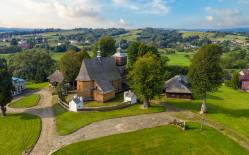
Recommended venues on the Trail
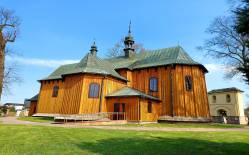
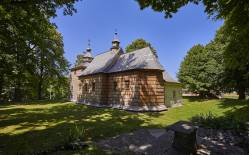
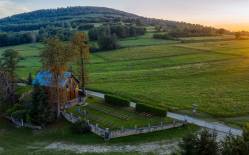
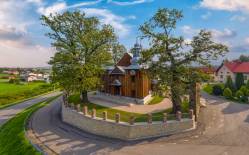



This website has been modernized with the financial support of the European Union under the Cross-Border Cooperation Programme Poland-Belarus-Ukraine 2014-2020. The responsibility for its content lies solely with the Podkarpackie Regional Tourism Board and cannot, in any case, be treated as a reflection of the position of the European Union, the Managing Authority, or the Joint Technical Secretariat of the Cross-Border Cooperation Programme Poland-Belarus-Ukraine 2014-2020.










